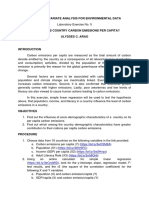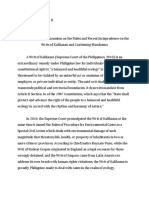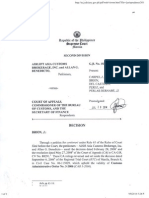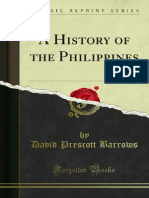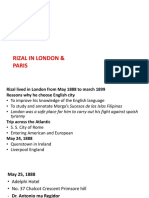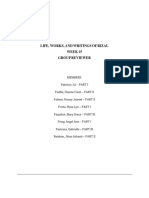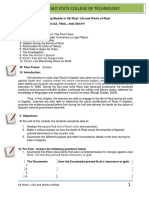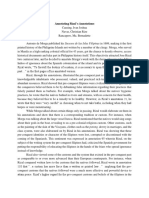This Is S A File About Accounting
This Is S A File About Accounting
Uploaded by
Ashley ZapantaCopyright:
Available Formats
This Is S A File About Accounting
This Is S A File About Accounting
Uploaded by
Ashley ZapantaOriginal Description:
Original Title
Copyright
Available Formats
Share this document
Did you find this document useful?
Is this content inappropriate?
Copyright:
Available Formats
This Is S A File About Accounting
This Is S A File About Accounting
Uploaded by
Ashley ZapantaCopyright:
Available Formats
PRIMARY SOURCE ANALYSIS
Title of Source: EXCERPT FROM SUCESOS DE LAS ISLAS FILIPINAS
Type of Primary Source: A written account by Antonio de Morga
Who is the author of the primary source? What do you know about the author that may shape his/her perspective?
The author of Sucesos de las Islas Filipinas is Antonio de Morga. He was a Spanish high-ranking official in the Philippines from 1593 to1603. He is a lawyer and held the position of oidor or
judge of the Real Audiencia.
Who is the intended audience of the primary source?
This written account is primarily intended for Spaniards. The discoveries of Antonio de Morga are useful in understanding the culture of ancient Filipinos.
CONTENT & CONTEXT
Where and when was the primary source published or created?
The primary source was published at Mexico in 1609.
Describe the historical context. What was happening during this event or time period?
In this context, the events happened in the early Spaniards colonization in the Philippines. They explore the culture of ancient Filipinos. They try to understand the traditions and customs that early
Filipinos practice.
OBSERVE EXPLAIN INFER WONDER
DESCRIPTION OF SOURCE: MEANING: MESSAGE/ ARGUMENT: QUESTIONS:
What do you observe? Consider the images, What is the meaning of the objects, words, What sentiment (attitude or feeling) do you think What about the source makes you curious?
people, objects, activities, actions, words, symbols, etc.? the author is trying to convey through the source? What questions still remain? What additional
phrases, facts, and numbers. What, based on the source, can you infer about the information would you need to know in order
historical event or time period? to deepen your understanding of the ideas
expressed in the source?
The account discussed the tradition and 1. Bagoong or fish Paste – Morga’s term for Analyzing the excerpt of Antonio de Morga, he • How did people in precolonial and colonial
culture of early Filipinos. Specifically, this food is decayed fish discussed the old-age delicacy specifically the period discover the Buyo or Betel chew?
regarding the traditional food that they 2. Nganga or betel chew – a Filipino food gastronomic culture of nganga or betel chew. In the • Why did the author, Antonio de Morga,
eat. It discussed a seemingly irrelevant 3. Buyo – made from a tree whose shaped like excerpt of his work, he narrated the preparation, decided to make an article about Betel chew
and outdated parcel of our gastronomic the tree of mulberry process, health benefits, practices and preparation. among other Filipino delicacies?
culture, the nganga or the betel chew. 4. Bonga – the fruit resembles an oak acorn Based on his work, he pointed out the gastronomy of • How did early Filipinos become fond of
In addition, in this article it explained the and white inside early Filipinos played a vital role in the lives of eating decayed fish?
benefits that they may acquire in chewing people in pre-colonial and colonial periods. He didn’t
5. Capa (Sapa) – the juice
this so called nganga. One example of the critize this practice, nganga or betel chew, unlike the
6. Buccetas – boxes of buyos
benefits of nganga is when the juice gets eating of bagoong or fish paste that annotated by
into the stomach it strengthens the body Jose Rizal.
in various diseases.
Also, in this written account it stated that
this nganga is always present in every
individuals. For example, the natives
especially the chiefs take whenever they
leave their houses for show and
entertainment their boxes of buyos which
they called buccetas.
Created by John DePasquale for classroom use
You might also like
- Primary Source Analysis: Title of Source: Customs of The TagalogDocument2 pagesPrimary Source Analysis: Title of Source: Customs of The TagalogJohn Patrick Camacho0% (1)
- This Study Resource Was: Analyzing Historical DocumentDocument5 pagesThis Study Resource Was: Analyzing Historical DocumentBernarize Velasco PaggaoNo ratings yet
- Rizal's Annotation of The Morga PDFDocument27 pagesRizal's Annotation of The Morga PDFRey Russel Macalibo Dayahan100% (3)
- Chapter 5 - Auditory Art and Performing ArtsDocument15 pagesChapter 5 - Auditory Art and Performing ArtsJo Grace PazNo ratings yet
- Rebirth of FreedomDocument37 pagesRebirth of FreedomLowellyn Grezen VillaflorNo ratings yet
- Lesson Guide in SSP 114 - EthicsDocument4 pagesLesson Guide in SSP 114 - EthicsQuennie Marie ZuycoNo ratings yet
- 1f Nature and Effects of Obligations by DeleonDocument17 pages1f Nature and Effects of Obligations by DeleonFerry FrondaNo ratings yet
- Rizal'S Education in ManilaDocument1 pageRizal'S Education in ManilalizNo ratings yet
- LAB Exercise No. 5Document3 pagesLAB Exercise No. 5August August AugustNo ratings yet
- F1.1 The Constitution of The PhilippinesDocument15 pagesF1.1 The Constitution of The PhilippinesIcah VillanuevaNo ratings yet
- Writ of Kalikasan Paper For CLAUDIEDocument3 pagesWrit of Kalikasan Paper For CLAUDIERuth TenajerosNo ratings yet
- RPH ReviewerDocument5 pagesRPH Reviewershania AcunaNo ratings yet
- 8.US vs. Reyes, March 1, 1993Document15 pages8.US vs. Reyes, March 1, 1993Vince EnageNo ratings yet
- Eng 306 Module StudentDocument239 pagesEng 306 Module StudentCherry Ann Marcial NabascaNo ratings yet
- Senior High School: I. Gaining in Your EndDocument15 pagesSenior High School: I. Gaining in Your EndMae Ann Piorque100% (1)
- Assessment 4 Comparative Analysis: Primary Vs Secondary SourcesDocument2 pagesAssessment 4 Comparative Analysis: Primary Vs Secondary SourcesGerald PerionNo ratings yet
- Politics State (People)Document22 pagesPolitics State (People)Johney DoeNo ratings yet
- How Is Art Related To Humanities?Document5 pagesHow Is Art Related To Humanities?Winter SummerNo ratings yet
- HISTORY - The Trials of RizalDocument18 pagesHISTORY - The Trials of RizalElleNo ratings yet
- Reviewer MidtermDocument4 pagesReviewer MidtermTrisha mae Cruz100% (2)
- Super Digest 1 - 5Document7 pagesSuper Digest 1 - 5Krystal Grace D. PaduraNo ratings yet
- REAPHISDocument3 pagesREAPHISCZARINA JOVIENNE PUMANESNo ratings yet
- Other Names of ChinaDocument4 pagesOther Names of ChinakonyatanNo ratings yet
- Chapter 4 Pre-ActivityDocument6 pagesChapter 4 Pre-ActivityKen Christian GonzalesNo ratings yet
- Ra 9520Document10 pagesRa 9520Kim Patrick MarianoNo ratings yet
- Rizals Life, Exile Trial and DeathDocument68 pagesRizals Life, Exile Trial and DeathJochebed MirandaNo ratings yet
- Subject and Content of ArtDocument6 pagesSubject and Content of ArtRyzeNo ratings yet
- SC Decision Vs CAO 3-2006 (Broker Accreditation by The BOC)Document8 pagesSC Decision Vs CAO 3-2006 (Broker Accreditation by The BOC)PortCalls100% (1)
- Lilia, Ma. Angelika C. - Scarborough Shoal - SourceDocument5 pagesLilia, Ma. Angelika C. - Scarborough Shoal - SourceAngel Cipriano LiliaNo ratings yet
- Character Analysis of Mercy in OndoyDocument3 pagesCharacter Analysis of Mercy in OndoyBanadhi Kurnia DNo ratings yet
- Ollendorff v. AbrahamsonDocument8 pagesOllendorff v. AbrahamsonjNo ratings yet
- Quiz AnswersDocument4 pagesQuiz AnswersEarl averzosaNo ratings yet
- Ge8 Week 4Document21 pagesGe8 Week 4JANE JAMON100% (1)
- Lesson 1 - Subject and Content of ArtDocument10 pagesLesson 1 - Subject and Content of ArtJoemar BenitoNo ratings yet
- Philippine Indigenous Community: Name: Marzon, Jeraldin R. Section Code and Schedule: Pced-03-401PDocument64 pagesPhilippine Indigenous Community: Name: Marzon, Jeraldin R. Section Code and Schedule: Pced-03-401PDen-den Roble MarzonNo ratings yet
- The White BirdDocument1 pageThe White BirdJude Mari UbaldeNo ratings yet
- History of The Filipino People by TeodoroagoncillopdfebookDocument3 pagesHistory of The Filipino People by Teodoroagoncillopdfebookert0724% (17)
- GE 6 - Chapter 4Document3 pagesGE 6 - Chapter 4Albert Carl Baltazar IINo ratings yet
- Philippine History and Literature (Module 3)Document5 pagesPhilippine History and Literature (Module 3)Zarlene Sierra100% (2)
- Comelec Res 9648Document39 pagesComelec Res 9648kyroe104No ratings yet
- BSEd 1 Ethics Activity 3 (Midterm)Document3 pagesBSEd 1 Ethics Activity 3 (Midterm)Blessed Mae JacintoNo ratings yet
- OBLIGATIONS AND CONTRACTS Session 4Document67 pagesOBLIGATIONS AND CONTRACTS Session 4Mary Ann BandolaNo ratings yet
- A Module in GE 2:: Readings in Philippine HistoryDocument30 pagesA Module in GE 2:: Readings in Philippine HistoryJazzy Reig100% (1)
- GEETHIC - A Class Summary of Eastern SpiritualityDocument20 pagesGEETHIC - A Class Summary of Eastern SpiritualityNicolas Ryan Villar100% (1)
- Critique Paper of Goyo Ni MonaDocument4 pagesCritique Paper of Goyo Ni MonaAljon Jacobe100% (1)
- Unit 5 Topic 2 Appreciating The Philippine Indigenous ArtDocument6 pagesUnit 5 Topic 2 Appreciating The Philippine Indigenous ArtTV BOX MXQ PRONo ratings yet
- Train Law RecommendationDocument10 pagesTrain Law RecommendationMaria Angelica PanongNo ratings yet
- Ethics - Chap 9Document3 pagesEthics - Chap 9HzlannNo ratings yet
- Filipino GrievancesDocument1 pageFilipino GrievancesemanNo ratings yet
- Reflection Paper in Allegory of The CaveDocument3 pagesReflection Paper in Allegory of The CaveAldrin De GuzmanNo ratings yet
- Fabro Bsa Bba M1a1 HistoryDocument1 pageFabro Bsa Bba M1a1 HistoryAIENNA GABRIELLE FABRONo ratings yet
- Chap 1 - Introduction - 4thDocument3 pagesChap 1 - Introduction - 4thMarvin Celedio100% (4)
- Western MovementDocument5 pagesWestern MovementKee Jeon DomingoNo ratings yet
- R. A. No. 8371 Official Gazette of The Republic of The PhilippinesDocument29 pagesR. A. No. 8371 Official Gazette of The Republic of The PhilippinesJella BandalanNo ratings yet
- Essay (T'Nalak Cloth)Document1 pageEssay (T'Nalak Cloth)Jamycka AntolinNo ratings yet
- Activity No. 9 Citizen Participation in ElectionDocument5 pagesActivity No. 9 Citizen Participation in ElectionAlhaina JulkanainNo ratings yet
- The Giantess and The Three ChildrenDocument2 pagesThe Giantess and The Three ChildrenGwenNo ratings yet
- Land Transpotation Cases (Recovered)Document150 pagesLand Transpotation Cases (Recovered)Notaly Mae Paja BadtingNo ratings yet
- MODULES1 and 2Document5 pagesMODULES1 and 2Jayson MirandaNo ratings yet
- Week 14 - JusticeDocument37 pagesWeek 14 - JusticePCPT SHARON MALLILLINNo ratings yet
- Unit2 Act4 PhilHistoryDocument4 pagesUnit2 Act4 PhilHistoryFrost BiteNo ratings yet
- Adobo - and CMDocument23 pagesAdobo - and CMliyam jamesNo ratings yet
- Annotating Colonial Histories Group 7 Final OutputDocument14 pagesAnnotating Colonial Histories Group 7 Final OutputKris Joseph LasayNo ratings yet
- Antonio de Morga - 16 Century Lieutenant Governor of The PhilippinesDocument2 pagesAntonio de Morga - 16 Century Lieutenant Governor of The PhilippinesIrene Kaye AceroNo ratings yet
- GE9 Module 6 Annotations of Antonio Morgas Sucesos de Las Islas FilipinasDocument11 pagesGE9 Module 6 Annotations of Antonio Morgas Sucesos de Las Islas Filipinasmark laurelNo ratings yet
- Ateneo de Manila University Philippine StudiesDocument32 pagesAteneo de Manila University Philippine StudiesAshley MendozaNo ratings yet
- Lecture 10 (Gec-Rizal)Document15 pagesLecture 10 (Gec-Rizal)Clarisse RuizNo ratings yet
- GE 2 - Learning Manual - For PrintDocument52 pagesGE 2 - Learning Manual - For PrintKianggNo ratings yet
- Chapter 8 - Rizals Annotation To Antonio de Morgas Sucesos de Las Islas FilipinasDocument6 pagesChapter 8 - Rizals Annotation To Antonio de Morgas Sucesos de Las Islas Filipinasjhonfel alviolaNo ratings yet
- Handout in Rizal G 2Document9 pagesHandout in Rizal G 2batojenniferestreraNo ratings yet
- Report in RizalDocument17 pagesReport in RizalSherwin Buenavente SulitNo ratings yet
- Annotation of Antonio Morga Sucesos de Las Islas FilipinasDocument35 pagesAnnotation of Antonio Morga Sucesos de Las Islas FilipinasMary Jean C. Dedil100% (2)
- A History of The PhilippinesDocument341 pagesA History of The PhilippinesGennaro MassaNo ratings yet
- Hist10 Module7 Lesson12Document18 pagesHist10 Module7 Lesson12Dungan, Andrew JohnNo ratings yet
- Week 9 Rizals Life and Works in London and ParisDocument33 pagesWeek 9 Rizals Life and Works in London and ParisVencint LaranNo ratings yet
- Rizal Module 6Document6 pagesRizal Module 6Given Grace AlvarezNo ratings yet
- Rizal'S Annotation of Sucesos de Las Islas FilipinasDocument3 pagesRizal'S Annotation of Sucesos de Las Islas FilipinasCatherineNo ratings yet
- Rizal Annotation of MorgaDocument3 pagesRizal Annotation of Morgajessamie balili100% (1)
- Sucesos de Las Islas FilipinasDocument15 pagesSucesos de Las Islas FilipinasSheen Senilong0% (1)
- Manila Bulletin Rizal Annotates Antonio de MorgaDocument9 pagesManila Bulletin Rizal Annotates Antonio de MorgaJanlenn GepayaNo ratings yet
- RIZAL-Final Exam CoverageDocument4 pagesRIZAL-Final Exam CoverageMean MirafuentesNo ratings yet
- RIZL211 WEEK15 Group ReviewerDocument9 pagesRIZL211 WEEK15 Group ReviewerMARY GRACE PAQUIBOTNo ratings yet
- Annotation of Antonio de Morga (Written Report)Document8 pagesAnnotation of Antonio de Morga (Written Report)RJ EscañoNo ratings yet
- Surigao State College of Technology: Learning ModuleDocument42 pagesSurigao State College of Technology: Learning ModuleJenemarNo ratings yet
- Life and Works of Rizal Rizal'S Annotation of Antonio Morga'S "Sucesos de Las Isla Filipina" and Philippine NationalismDocument6 pagesLife and Works of Rizal Rizal'S Annotation of Antonio Morga'S "Sucesos de Las Isla Filipina" and Philippine NationalismMarie Vivialyn SerranoNo ratings yet
- Commentary On Rizal's MorgaDocument5 pagesCommentary On Rizal's MorgaGIAN CARLO CONEL100% (4)
- To The Young Womens of Malolos 1Document94 pagesTo The Young Womens of Malolos 1clint ford Espanola100% (1)
- RizalDocument3 pagesRizalGreg PanteNo ratings yet
- GECLIF-Module 3 - Annotation of Morga S Sucesos de Las Islas FilipinasDocument37 pagesGECLIF-Module 3 - Annotation of Morga S Sucesos de Las Islas Filipinasching100% (1)
- ANNOTATIONSDocument23 pagesANNOTATIONSRose Belle A. GarciaNo ratings yet








